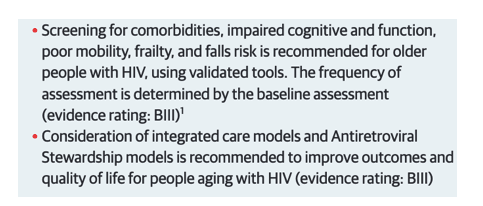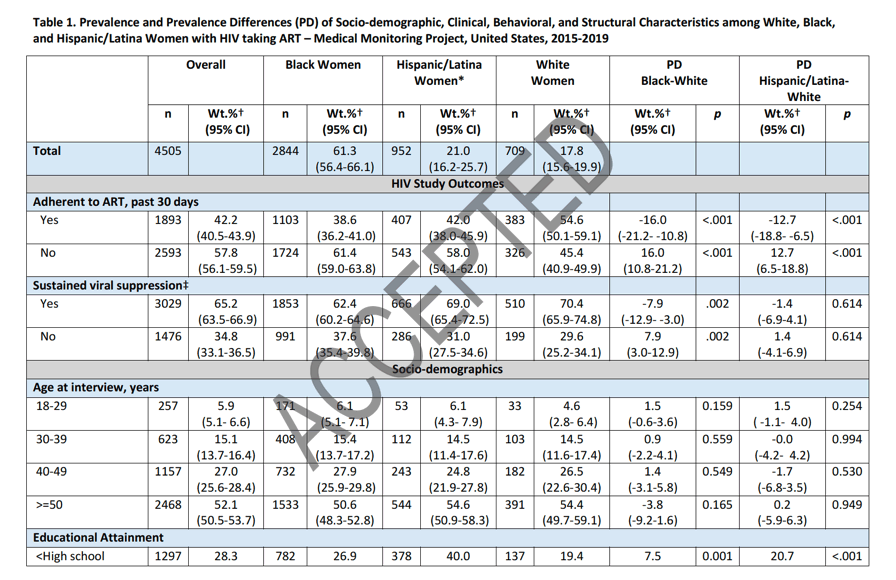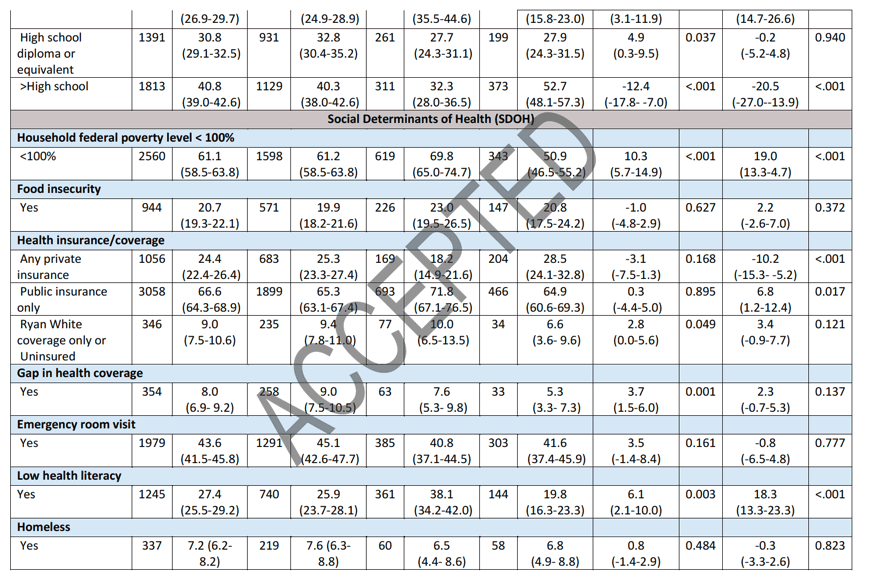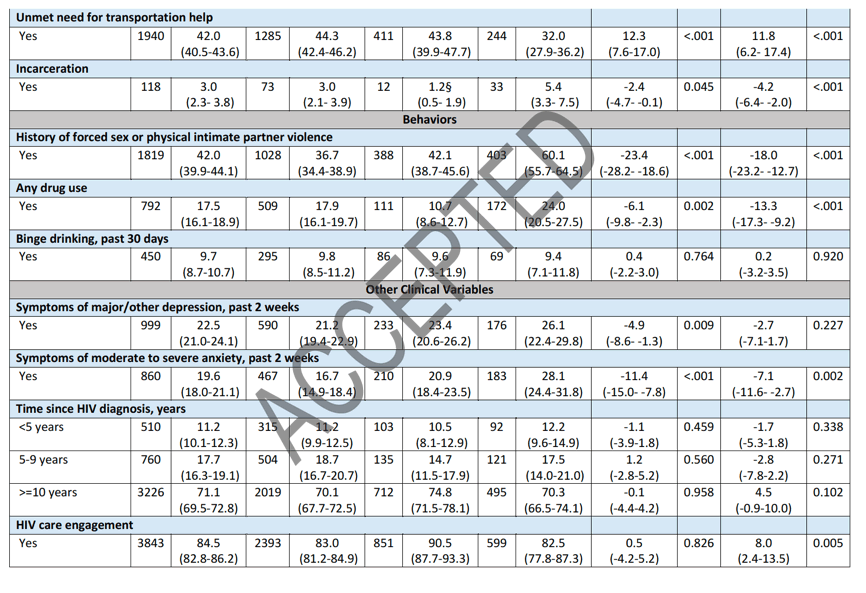| |
Disparities in Adherence & Viral Suppression:
"Racial and ethnic disparities in HIV care outcomes
must be ameliorated if we are to meet the goals of the EHE and NHAS"
|
| |
| |
Download the PDF here
-------------------------------------------------------------
I don't see how Ending the Epidemic is possible without addressing these disparities and resolving the Aging & HIV problem of considerable unmet needs many older & elderly PWH face daily in not being able to receive good or even adequate clinical care & services. IAS-USA Guidelines recommend PWH over 50 receive geriatric screenings - that are not being provided however and NYS just issued new Aging/HIV Assessment Guidelines but these are merely guidelines yet have no teeth for enforcement without adequate funding fir clinics. Jules Levin NATAP
New NYS Clinical Guidance: Addressing the Needs of Older Patients in HIV Care - (05/11/23)
New HIV Guidelines IAS-USA Panel; Aging, Weight

Aging & Disproportionate disability in people with HIV - (02/20/23)
The call from UNAIDS in 2021 for 90% of people with HIV to have access to services for chronic comorbidities as part of their HIV care is an essential step to address these gaps in practice, but more needs to be done to operationalize this target.
------------------------------------------

"Racial and ethnic disparities in HIV care outcomes must be ameliorated if we are to meet the goals of the EHE and NHAS"
We used data from the 2015-2019 cycles of the Medical Monitoring Project, a probability sample of U.S. adults with diagnosed HIV. Using logistic regression with predicted marginal means, we calculated weighted prevalence differences (PDs) of ART adherence and SVS among Black, Hispanic/Latina, and White women taking ART. Using modeling with forward stepwise selection, we adjusted PDs for selected variables, including social determinantsof health (SDOH) factors, to examine whether magnitude of PDs was attenuated by their inclusion. We assessed relative changes between unadjusted and adjusted PDs.
The overall percentage of women taking ART and maintaining SVS in the 2015-2019 MMP cycles was below the goal outlined in the 2030 National HIV/AIDS Strategy (NHAS) for the United States-to increase viral suppression among people with diagnosed HIV to at least 90%.6 Moreover, compared with White women (54.6%),
ART adherence was lower among Black (38.6%) and Hispanic/Latina women (42.0%) and compared to White women (70.4%), SVS was lower among Black women (62.4%). While this study assessed 100% ART adherence during the past 30 days, the finding that more women reached SVS during the year than reported past-month 100% ART adherence aligns, given viral suppression only requires initial adherence of 95% for many ART combinations23 and requires only 80% of doses taken as prescribed for protease inhibitor-boosted regimens.24,25
"Overall, 42.2% of women were ART adherent over the past 30 days and 65.2% had SVS over the past 12 months."
"The prevalence of ART adherence was 38.6% among Black women, 42.0% among Hispanic/Latina women, and 54.6% among White women."
CONCLUSION
• Less than half of U.S. women with HIV who were taking ART were medication adherent.
• Furthermore, viral suppression was suboptimal overall, and significantly lower for Black women in comparison to White women.
• Racial and ethnic disparities in HIV care outcomes must be ameliorated if we are to meet the goals of the EHE and NHAS and realize a more equitable landscape for HIV prevention and care.
The recommendations outlined above in the (Discussion see attached pdf full article: itemized below) align with the CDC's Division of HIV Prevention's priorities for the Treat pillar of the EHE.6
Recommendations
1. Specifically, to consider provider-level or system-level strategies for improving ART adherence and SVS, as these strategies may have broader reach or be more sustainable, and develop interventions to address the social determinants (e.g., economic inequalities) that negatively affect ART use and adherence and viral suppression among PWH."
2. "To improve equity in HIV treatment and care outcomes among women with HIV, our findings suggest the need to address racial and ethnic disparities in poverty, need for transportation assistance, health literacy, and consistent health insurance coverage, and need for implementing related solutions that will reduce these inequities in American society."
3. With respect to transportation assistance, an estimated 3.6 million patients experience transportation barriers to healthcare each year.28 Women with HIV who are engaged in HIV care can access transportation assistance via the Ryan White HIV/AIDS Program. Structural-level interventions for women needing transportation assistance can also include offering home delivery and 90-day prescriptions (as opposed to 30-day prescriptions)29 and medication synchronization, or the practice of arranging all of a patient's medications to be refilled on the same date.30
4. Many racial/ethnic minority women in this study reported limited health literacy, which may translate into low self-efficacy to manage prescriptions-both of which can directly affect medication adherence, and subsequently, based on our findings, SVS. While an individual-level approach to increasing patient self-efficacy to understand and manage prescriptions might be to increase health literacy, intervening at a structural level might involve, for example, providing medication in blister pill packs with the date and time on them for patients who take multiple medications. Identifying and implementing solutions for increasing medication adherence is critical for increasing SVS.
5. barriers and facilitators to HIV care engagement among PWH who participated in the MMP from June 2018 to May 2019 and were not engaged in HIV care. Several system- and structural-related facilitators to engaging in care were noted. System-related facilitators included positive attributes of patient-provider relationships (e.g., providers who are empathic, are nonjudgmental, engage patients in a conversation, and take time to listen) and flexible appointments (e.g., scheduled soon after requested or offered outside traditional work hours).31
6. Structural-level facilitators of care included transportation (e.g., access to public and private transportation; having available public transportation routes close to home and health care facilities; and reducing, subsidizing or eliminating the cost of transportation); health insurance (e.g., reducing, subsidizing or eliminating cost associated with seeking care); and financial help (e.g., being employed and securing income is a precursor to seeking care).31 If research suggests that PWH in care experience the same issues that those PWH who are of out of care report are barriers to engaging in care, then an argument can be made that those in care are susceptible or at risk of falling out of care if these issues are not addressed. Black and Hispanic/Latina women in this study were "in care" with respect to taking ART, yet disparities in ART adherence and SVS were still evident and associated with structural-level factors like transportation, health insurance, and financial need (i.e., poverty). Simply being "in care" is not enough to reduce these inequities.
7. Patient-provider relations and healthcare discrimination are two factors not included in the current analyses (due to changes across MMP cycles that precluded their inclusion) that may help answer the question as to why racial/ethnic disparities in some outcomes were reduced but not eliminated. An important caveat for successfully implementing financial-based structural-level interventions as proposed above is that, before a provider can direct a patient to financial resources that will aid in their ability to be medically adherent, they must first develop a rapport with patients, as a lack of trust can subvert the necessary step of identifying patients who need financial assistance. Negative clinical encounters by racial/ethnic minority women are well documented.32,33 Increasing equitable access to HIV care and treatment services can be accomplished by developing social and structural interventions that address the patient-provider relationship as well as overcoming some of these challenges by providing a "One Stop Shop" (or all-inclusive) module of health-related service delivery.34,35



|
|
| |
| |
|
|
|